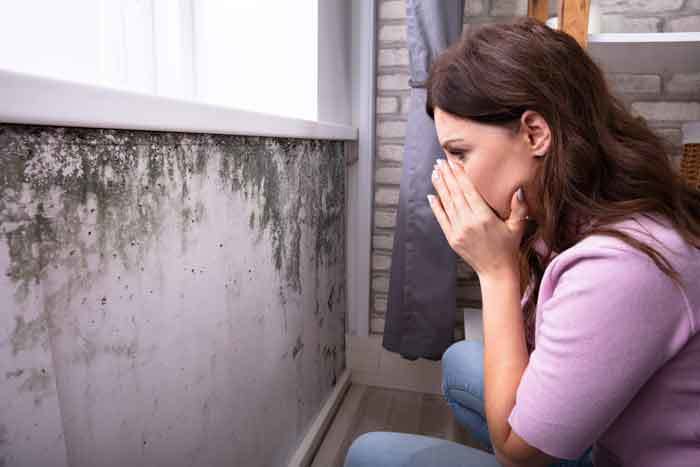Can Mold Cause Strep Throat? – A COMPLETE Guide
As an Amazon Associate, I may earn from qualifying purchases at no extra cost to you.

Worried about that sore throat that’s still bothering you, even after it’s been over two days and it should have gone away by now?
If your sore throat isn’t accompanied by a cough or a cold, and you have started to notice little red spots appearing on the roof of your mouth, then your sore throat is may probably be strep throat.
More...
How is strep throat different from a normal sore throat?

Strep throat is not as common as your everyday sore throat. In fact, a child is more likely to get it than you are.
We understand mistaking it for a sore throat, because these two ailments have a lot of symptoms in common, like a scratchy, sometimes swollen throat, a fever, and even difficulty breathing.
But you’re probably suffering from a strep throat if you don’t have a cough or a cold to go along with your itchy throat.
Or you may experience the following symptoms.
What is strep throat?

The first thing that you should know is that strep throat is contagious.
So keep away from anyone who may be susceptible to getting strep throat, because you wouldn’t want to wish it on anyone.
It is extremely painful, especially for little kids!
Strep throat is caused by Streptococcal bacteria, which has a high rate of contagion.
Even just sneezing or coughing in someone’s direction, or sharing food and drinks with someone opens them up to the risk of developing strep throat.
You can even share this virus to people you live with if they use the same utensils as you do, or touch things that you may have sneezed or coughed on!
Extra caution is extremely important if you care for your family.
Don’t just brush it off like you would for sore throat – if left untreated, strep throat can lead to a lot of complications.
The infection may spread to your tonsils, sinuses, and your ear, and you can even develop other illnesses thanks to it!

Some of these include:
If you come into contact with a surface containing the Streptococcal bacteria, and use that very same hand to touch your face, especially your eyes or mouth, then you may very well be inviting the infection into your life.
How do I prevent getting strep throat?

There are a number of ways you can do to avoid getting infected.
Because the ailment is caused by a certain type of bacteria, you can avoid suffering from such a severe reaction to it by boosting your immune system – just do the things your doctor would typically as of you, like:
If someone you know is infected, stay far from that person!
As we said before, strep throat is highly contagious, and most people only develop strep throat from the infected people around them.
As bad as this sounds – don’t share personal items.
That’s right, even letting your best friend sip from your soda drink should be avoided, if you want to avoid infection.
The same should and can be said for other items that you may use regularly – your eating and cooking utensils, if used by someone already suffering from a sore throat, should be put out of commission for a while.
Homeowners – especially parents – also typically ask if there’s an environmental factor that could be causing their throat pains.
Could a mold growth in your homes be causing your sore and strep throats?

You’ve heard of mold spores taking root in your home, and perhaps you’ve even installed dehumidifiers to keep them away, but mold may carry health risks that can go even beyond your average sniffles.
Some types of mold can ignite an allergic reaction with some particularly unlucky people.
This mold releases mycotoxins, which triggers your body’s immune system, causing a cough or a cold or even a sore throat in an effort to fight off the harmful chemicals.
Your body’s reaction to the mycotoxins is likely what’s causing you misery.
Unfortunately, a sore throat isn’t the only way your body responds to these allergens – you can also develop a postnasal drip, rashes, or even a headache.
So mold can cause sore throats – what about strep throats?

Can mold cause strep throat?
Simply speaking, mold is not known to cause strep throat – we’ve established that strep throat is brought about by Streptococcal bacteria.
Take note though, the mold growth in your home may very well become a breeding ground for this type of bacteria.
To keep you and your family safe from making contact with Streptococcal bacteria, make sure that you aren’t inviting mold spores into your home, through following these simple steps:
There are a number of ways you can discourage mold growth in your home, and having read the symptoms of strep throat, it’s better to be safe than sorry.
Conclusion: Can Mold Cause Strep Throat?

A sore throat may not exactly be the same as strep throat, but both can be an inconvenience at least, and misery at most – it’s no fun to wince in pain every time you try to swallow!
So watch out for symptoms of strep throat, most commonly the unfamiliar white and red spots showing up at the back of your throat, and when you see them, run – to the doctor, that is.
You’ll be prescribed with some antibiotics, and after a day or two you should be better.
But the easy fix doesn’t mean you should underestimate both ailments.
It’s still better to try and avoid getting them in the first place, so if you follow the instructions above, like keeping away from infected people and keeping utensils to yourself, then you should be fine.
Of course, keep your home safe too – prevent mold growth by sniffing out areas with moisture, and don’t let the Streptococcal bacteria find a cozy place to stay in your home, and in your throats!
You may also like: How to get rid of mold in Sinuses?.
